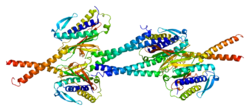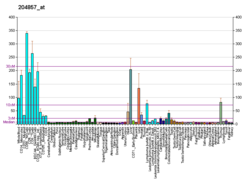Protein-coding gene in the species Homo sapiens
Mitotic spindle assembly checkpoint protein MAD1 is a protein that in humans is encoded by the MAD1L1 gene .[ 5] [ 6] [ 7]
MAD1L1 is also known as Human Accelerated Region 3. It may have played a key role in the evolution of humans from apes.[ 8]
Function
MAD1L1 is a component of the mitotic spindle-assembly checkpoint that prevents the onset of anaphase until all chromosome are properly aligned at the metaphase plate. MAD1L1 functions as a homodimer and interacts with MAD2L1 . MAD1L1 may play a role in cell cycle control and tumor suppression. Some studies indicate associations of MAD1L1 with psychiatric disorders, including schizophrenia, bipolar disorder, and depression. [ 9] [ 10] [ 11] [ 7]
Interactions
MAD1L1 has been shown to interact with:
See also
References
^ a b c GRCh38: Ensembl release 89: ENSG00000002822 – Ensembl , May 2017^ a b c GRCm38: Ensembl release 89: ENSMUSG00000029554 – Ensembl , May 2017^ "Human PubMed Reference:" . National Center for Biotechnology Information, U.S. National Library of Medicine .^ "Mouse PubMed Reference:" . National Center for Biotechnology Information, U.S. National Library of Medicine .^ Jin DY, Kozak CA, Pangilinan F, Spencer F, Green ED, Jeang KT (February 1999). "Mitotic checkpoint locus MAD1L1 maps to human chromosome 7p22 and mouse chromosome 5" . Genomics . 55 (3): 363– 364. doi :10.1006/geno.1998.5654 . PMID 10049595 . ^ Jin DY, Spencer F, Jeang KT (April 1998). "Human T cell leukemia virus type 1 oncoprotein Tax targets the human mitotic checkpoint protein MAD1" . Cell . 93 (1): 81– 91. doi :10.1016/S0092-8674(00)81148-4 PMID 9546394 . S2CID 7345931 . ^ a b "Entrez Gene: MAD1L1 MAD1 mitotic arrest deficient-like 1 (yeast)" .^ Kostka D, Hubisz MJ, Siepel A, Pollard KS (March 2012). "The role of GC-biased gene conversion in shaping the fastest evolving regions of the human genome" . Molecular Biology and Evolution . 29 (3): 1047– 1057. doi :10.1093/molbev/msr279 . PMC 3278478 PMID 22075116 . ^ Lam M, Chen CY, Li Z, Martin AR, Bryois J, Ma X, et al. (December 2019). "Comparative genetic architectures of schizophrenia in East Asian and European populations" . Nature Genetics . 51 (12): 1670– 1678. doi :10.1038/s41588-019-0512-x . PMC 6885121 PMID 31740837 . ^ Hou L, Bergen SE, Akula N, Song J, Hultman CM, Landén M, et al. (August 2016). "Genome-wide association study of 40,000 individuals identifies two novel loci associated with bipolar disorder" . Human Molecular Genetics . 25 (15): 3383– 3394. doi :10.1093/hmg/ddw181 . PMC 5179929 PMID 27329760 . ^ Sokolov AV, Manu DM, Nordberg DO, Boström AD, Jokinen J, Schiöth HB (January 2023). "Methylation in MAD1L1 is associated with the severity of suicide attempt and phenotypes of depression" . Clinical Epigenetics . 15 (1): 1. doi :10.1186/s13148-022-01394-5 PMC 9811786 PMID 36600305 . ^ a b Yoon YM, Baek KH, Jeong SJ, Shin HJ, Ha GH, Jeon AH, et al. (September 2004). "WD repeat-containing mitotic checkpoint proteins act as transcriptional repressors during interphase" . FEBS Letters . 575 (1– 3): 23– 29. doi :10.1016/j.febslet.2004.07.089 PMID 15388328 . S2CID 21762011 . ^ Rual JF, Venkatesan K, Hao T, Hirozane-Kishikawa T, Dricot A, Li N, et al. (October 2005). "Towards a proteome-scale map of the human protein-protein interaction network". Nature . 437 (7062): 1173– 1178. Bibcode :2005Natur.437.1173R . doi :10.1038/nature04209 . PMID 16189514 . S2CID 4427026 . ^ Sironi L, Melixetian M, Faretta M, Prosperini E, Helin K, Musacchio A (November 2001). "Mad2 binding to Mad1 and Cdc20, rather than oligomerization, is required for the spindle checkpoint" . The EMBO Journal . 20 (22): 6371– 6382. doi :10.1093/emboj/20.22.6371 . PMC 125308 PMID 11707408 . ^ Murakumo Y, Roth T, Ishii H, Rasio D, Numata S, Croce CM, Fishel R (February 2000). "A human REV7 homolog that interacts with the polymerase zeta catalytic subunit hREV3 and the spindle assembly checkpoint protein hMAD2" . The Journal of Biological Chemistry . 275 (6): 4391– 4397. doi :10.1074/jbc.275.6.4391 PMID 10660610 .




















